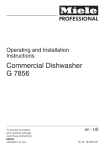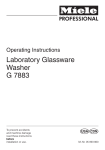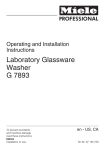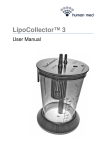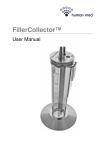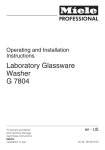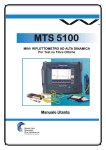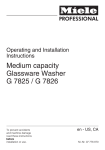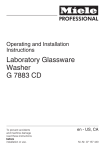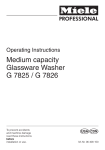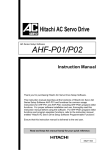Download Cisco Systems ATA 186 Telephone Accessories User Manual
Transcript
Operating Instructions Laboratory glassware washer G 7835 To prevent accidents and machine damage read these instructions before installation or use. UV M.-Nr. 06 214 820 Contents IMPORTANT SAFETY INSTRUCTIONS . . . . . . . . . . . . . . . . . . . . . . . . . . . . . . . . . 4 Guide to the machine. . . . . . . . . . . . . . . . . . . . . . . . . . . . . . . . . . . . . . . . . . . . . . . 8 Opening and closing the door . . . . . . . . . . . . . . . . . . . . . . . . . . . . . . . . . . . . . . 11 Electric door lock . . . . . . . . . . . . . . . . . . . . . . . . . . . . . . . . . . . . . . . . . . . . . . . . . . 11 To open the door with the emergency release. . . . . . . . . . . . . . . . . . . . . . . . . . . . 11 Water softener . . . . . . . . . . . . . . . . . . . . . . . . . . . . . . . . . . . . . . . . . . . . . . . . . . . 12 Setting the water softener . . . . . . . . . . . . . . . . . . . . . . . . . . . . . . . . . . . . . . . . . . . 13 Filling the salt reservoir . . . . . . . . . . . . . . . . . . . . . . . . . . . . . . . . . . . . . . . . . . . . . 14 Salt indicator . . . . . . . . . . . . . . . . . . . . . . . . . . . . . . . . . . . . . . . . . . . . . . . . . . . . . 15 Automatic mobile unit recognition (AWK) . . . . . . . . . . . . . . . . . . . . . . . . . . . . . 16 Mobile unit coding . . . . . . . . . . . . . . . . . . . . . . . . . . . . . . . . . . . . . . . . . . . . . . . . . 16 Mobile unit coding strip . . . . . . . . . . . . . . . . . . . . . . . . . . . . . . . . . . . . . . . . . . 17 Setting mobile unit coding . . . . . . . . . . . . . . . . . . . . . . . . . . . . . . . . . . . . . . . . 17 Applications . . . . . . . . . . . . . . . . . . . . . . . . . . . . . . . . . . . . . . . . . . . . . . . . . . . . . 19 Loading the machine . . . . . . . . . . . . . . . . . . . . . . . . . . . . . . . . . . . . . . . . . . . . . . . 19 Height adjustable top basket. . . . . . . . . . . . . . . . . . . . . . . . . . . . . . . . . . . . . . . . . 21 Laboratory glassware (LG) . . . . . . . . . . . . . . . . . . . . . . . . . . . . . . . . . . . . . . . . . . 22 Adding of liquid detergents and neutralizers . . . . . . . . . . . . . . . . . . . . . . . . . . 23 Preparing the DOS dispensers . . . . . . . . . . . . . . . . . . . . . . . . . . . . . . . . . . . . . . . 23 Filling the containers with liquid cleaning agents. . . . . . . . . . . . . . . . . . . . . . . 24 Priming the liquid dispensing systems . . . . . . . . . . . . . . . . . . . . . . . . . . . . . . . . . 25 Dispensing system maintenance. . . . . . . . . . . . . . . . . . . . . . . . . . . . . . . . . . . . . . 25 External Dispensing systems. . . . . . . . . . . . . . . . . . . . . . . . . . . . . . . . . . . . . . . . . 25 Operation . . . . . . . . . . . . . . . . . . . . . . . . . . . . . . . . . . . . . . . . . . . . . . . . . . . . . . . 26 Switching on / selecting or changing operating level . . . . . . . . . . . . . . . . . . . . . . 26 Turning on . . . . . . . . . . . . . . . . . . . . . . . . . . . . . . . . . . . . . . . . . . . . . . . . . . . . . . . 26 To change operating level . . . . . . . . . . . . . . . . . . . . . . . . . . . . . . . . . . . . . . . . . . . 26 Starting a program . . . . . . . . . . . . . . . . . . . . . . . . . . . . . . . . . . . . . . . . . . . . . . . . . 27 Program sequence . . . . . . . . . . . . . . . . . . . . . . . . . . . . . . . . . . . . . . . . . . . . . . . . 28 Turning off . . . . . . . . . . . . . . . . . . . . . . . . . . . . . . . . . . . . . . . . . . . . . . . . . . . . . . . 28 To change or cancel a program. . . . . . . . . . . . . . . . . . . . . . . . . . . . . . . . . . . . . . . 29 Canceling a program . . . . . . . . . . . . . . . . . . . . . . . . . . . . . . . . . . . . . . . . . . . . . . . 30 Serial interface . . . . . . . . . . . . . . . . . . . . . . . . . . . . . . . . . . . . . . . . . . . . . . . . . . . 31 2 Contents Cleaning and Care . . . . . . . . . . . . . . . . . . . . . . . . . . . . . . . . . . . . . . . . . . . . . . . . 32 Cleaning the filters in the wash cabinet . . . . . . . . . . . . . . . . . . . . . . . . . . . . . . . . . 32 Cleaning the coarse filter . . . . . . . . . . . . . . . . . . . . . . . . . . . . . . . . . . . . . . . . . 32 Cleaning the fine, flat and micro-fine filters . . . . . . . . . . . . . . . . . . . . . . . . . . . 33 Cleaning the drain pump and non-return valve . . . . . . . . . . . . . . . . . . . . . . . . . . . 34 Cleaning the water inlet filters . . . . . . . . . . . . . . . . . . . . . . . . . . . . . . . . . . . . . . . . 35 Cleaning the control panel. . . . . . . . . . . . . . . . . . . . . . . . . . . . . . . . . . . . . . . . . . . 35 Cleaning the exterior . . . . . . . . . . . . . . . . . . . . . . . . . . . . . . . . . . . . . . . . . . . . . . . 35 Drying unit (TA) - Cleaning and care . . . . . . . . . . . . . . . . . . . . . . . . . . . . . . . . . 36 Changing the coarse filter . . . . . . . . . . . . . . . . . . . . . . . . . . . . . . . . . . . . . . . . . . . 36 Replacing the HEPA-Filter . . . . . . . . . . . . . . . . . . . . . . . . . . . . . . . . . . . . . . . . . . . 37 Frequently asked questions . . . . . . . . . . . . . . . . . . . . . . . . . . . . . . . . . . . . . . . . 38 After sales service . . . . . . . . . . . . . . . . . . . . . . . . . . . . . . . . . . . . . . . . . . . . . . . . 39 INSTALLATION INSTRUCTIONS . . . . . . . . . . . . . . . . . . . . . . . . . . . . . . . . . . . . . 41 Caring for the environment . . . . . . . . . . . . . . . . . . . . . . . . . . . . . . . . . . . . . . . . . 42 Installation . . . . . . . . . . . . . . . . . . . . . . . . . . . . . . . . . . . . . . . . . . . . . . . . . . . . . . 43 Leveling the legs . . . . . . . . . . . . . . . . . . . . . . . . . . . . . . . . . . . . . . . . . . . . . . . . . . 43 Removing the lid (if necessary) . . . . . . . . . . . . . . . . . . . . . . . . . . . . . . . . . . . . . . . 43 Plumbing. . . . . . . . . . . . . . . . . . . . . . . . . . . . . . . . . . . . . . . . . . . . . . . . . . . . . . . . 44 Electrical connection . . . . . . . . . . . . . . . . . . . . . . . . . . . . . . . . . . . . . . . . . . . . . . 47 Technical Data . . . . . . . . . . . . . . . . . . . . . . . . . . . . . . . . . . . . . . . . . . . . . . . . . . . 49 3 IMPORTANT SAFETY INSTRUCTIONS This machine conforms to current safety requirements. Inappropriate use can however lead to personal injury and property damage. Read the operating instructions carefully before starting to use this machine. Keep these instructions in a safe place, and make them available to future users. Use This machine is designed for commercial use and for specialized applications only, as described in these Operating Instructions. Do not use for purposes other than those for which it was designed, as this might be dangerous. The programs are designed for laboratory glassware which are declared reprocessable. Regard the information from the glassware manufacturer. Miele is not responsible for damages caused by improper use. The installation of this unit in non stationary locations (e.g. ships) must be performed by a qualified installer or service agency, in strict accordance with national and local safety regulations and standards. 4 Please pay attention to the following notes, to maintain safe procedures. The machine should be commissioned and then maintained only by a Miele Service Technician. Repairs by unqualified persons could be dangerous. Do not install the machine in an area where a danger of explosion or freezing may be present. Be certain this appliance is properly installed and grounded by an authorized technician. To guarantee the electrical safety of this appliance, continuity must exist between the appliance and an effective grounding system. It is imperative that this basic safety requirement be met. If there is any doubt, have the electrical system checked by a qualified technician. The manufacturer cannot be held responsible for damage or injury caused by the lack of or inadequacy of an effective grounding system (e.g. electric shock). A damaged machine is dangerous. Turn off the machine immediately at the main switch and call the Miele Service Department. Personnel operating the machine should be trained regularly. Children and untrained personnel must not be allowed access to the machine or its controls. IMPORTANT SAFETY INSTRUCTIONS Take care when handling liquids such as detergents, neutralizing agents, wetting agents and rinse aids. These may contain irritant or corrosive ingredients, acids or alkalis. Never use any organic solvent, as the danger of an explosion exists. The manufacturer’s safety conditions must be observed with all chemical agents. ,Wear protective gloves and goggles. The water in the machine must not be used as drinking water. After drying with the TA drying unit open the door to allow the items and inserts to cool. Do not touch the heating elements during or directly after the end of a program, you could burn yourself. They remain hot for some time after the end of the program. Never clean near the machine with a water or a high pressure hose. Before servicing, disconnect the power supply by either removing the fuse, unplugging the unit or manually "tripping" the circuit breaker. Do not sit or lean on the open door or rest objects on it. This could cause the machine to tip and be damaged or cause an injury. Be careful when sorting items with sharp pointed ends. Position them in the machine that you do not hurt yourself or create danger for other operators. When using this machine regard the high temperatures and be especially careful not to scald or burn yourself. When opening the door bypassing the electrical lock, a danger of burning, scalding or corrosion exists. Let baskets and inserts cool before touching them. Any water which may remain in containers will be very hot and must be emptied into the wash cabinet. 5 IMPORTANT SAFETY INSTRUCTIONS The following points should be observed to assist in maintaining quality standards, for critical lab glassware, to protect patients, and to avoid damage to the loads being cleaned. If the cleaning result is subject to particularly stringent requirements (e.g. chemical analysis, specialized process), a regular quality control test should be carried out by the user to ensure that required standards of cleanliness are being achieved. If toxic or chemical substances are possible in the wash water regard the higher risk when interrupting a wash cycle and opening the door. Always check the seal of the door and the function of the steam condensator. Use only Miele approved cleaning agents with this machine. Use of unsuitable cleaning agents could adversely affect the components of the machine. Damages resulting from using unsuitable cleaning agents are not covered by the warranty. Pre-treating (e.g. with cleaning agents), certain soiling and cleaning agents with a chemical interaction, can cause foam. For pre-treatment and / or cleaning only use low-sudsing detergents and disinfecting agents which have been approved by Miele. Suds can have an adverse effect on the cleaning process. 6 When a chemical additive is recommended, the manufacturer of the machine takes no responsibility for the effect of the chemical on the material of the items being cleaned. Please be aware that changes in formulation, storage conditions, concentration etc, which may not be publicized by the chemical producer, can have a negative effect on the cleaning result. When using cleaning agents and specialized products it is essential that the manufacturer’s instructions are followed. Only use the product for the application described by the manufacturer to avoid any material damage or the occurrence of strong chemical reactions. The machine must only be operated with water and the recommended cleaning agents. Organic solvents must not be used in the machine, as there is the danger under certain circumstances of explosion. Although this is not the case with all organic solvents, other problems could arise with their use, for example damage to rubber and synthetic materials. IMPORTANT SAFETY INSTRUCTIONS In critical applications where very high requirements have to be met, it is strongly recommended that all the relevant factors for the process, such as cleaning agent, quality of water etc. are discussed with the Miele Applications Specialists. The mobile units and special inserts should only be used for their specific application. Empty any containers or utensils before arranging them in the machine. Do not allow any remains of acids or solvents, and in particular hydrochloric acid, chloride solutions or corroding ferrous material to get into the wash cabinet. Similarly avoid any materials with a corrosive effect. The presence in compounds of any solvents should be minimal. Ensure that solutions or steam containing hydrochloric acid do not come into contact with the steel outer casing of the machine to avoid any corrosion damage. Please follow the advice on installation in these instructions and the separate Installation Instructions. Using accessories Only specific additional equipment made by Miele should be connected to this machine. Consult the Miele Professional Group on the type and application of such equipment. Disposal of an old appliance When discarding a lab washer, disconnect it from the power supply, remove the door to the wash cabinet and cut off the power cord. For environmental and safety reasons ensure the machine is completely drained of any residue water and cleaning agent. (Observe safety regulations and wear safety goggles and gloves). Make the door lock inoperative, so that children cannot accidentally shut themselves in. Make appropriate arrangements for the safe disposal of the machine. If the machine contains a tank system, remove the water from the tank before disposing of the machine. The manufacturer cannot be held responsible for any damage caused through non-observance of these Warning and Safety Instructions. 7 Guide to the machine Electronic controls 8 Guide to the machine a Display with screen saver, background light switches off automatically after 15 minutes, hit any key to turn the background light on again. b On/Off button (I-0) c Cursor left moves the cursor to the left: – to the previous menu – to the previous parameter – to the previous input location d Cursor right moves the cursor to the right: – to the next menu – to the next parameter – to the next input location g Door switch h Start button – Starting a program – Activating insert mode – Confirming settings – Confirming menu points, to get to the respective submenu i Stop button – Canceling a program – Leaving the insert window without confirming – Leaving a menu j Optical interface (for service technician) k Program selector Selecting programs 1-23 e Minus button – program selection for programs over 24 – going back pagewise in menus – type in figures and letters – change default settings, e.g. service parameter f Plus button – program selection for programs over 24 – going forward pagewise in menus – type in figures and letters – change default settings, e.g. service parameter 9 Guide to the machine a Drying unit (TA) f Validation Access Port b Dispenser for neutralizing agent (red) and liquid detergent (blue) g Connection for DOS-module G 60 for addition of a third dosing line - rear side - c Filter combination d Salt reservoir (water softener) e Service panel 10 h Serial interface - rear side (left upper side, behind cover plate) - Opening and closing the door Electric door lock The machine is equipped with an electric door lock. The door can only be opened if: – the machine is connected to the electrical supply, – the ON/OFF button I-0 is pressed, and To open the door with the emergency release The emergency release should only be used when the door cannot be opened normally, e.g. in the case of a power failure. ^ Turn the machine off with I-0. – no wash program is running. Opening the door ^ Press the 5 door button, grasp the door handle and pull open the door. ,Do not touch the heating elements during or directly after the end of a program, you could burn yourself. They remain hot for some time after the end of the program. To close the door ^ Lift the door upwards and push until it clicks shut. ^ Reach up behind the service panel, located at the bottom of the machine, and pull the ring of the emergency release downwards. ,Do not use the emergency release when excessive temperatures have been reached in the cabinet. Danger of pressure wave release. Allow time for cooling. 11 Water softener Before using the machine for the first time, the water softener should be programmed. The water needs to be softened to avoid calcium deposit buildup on the items being cleaned and in the machine itself. To ensure a steady supply of soft water: 1. Make sure the water softener is programmed correctly. 2. The salt reservoir must be filled with reactivation salt. – If the water hardness is below 70 ppm (4 gr/gal) the reservoir does not need to be filled. Once the machine has been set accordingly the reactivation will no longer occur and the salt refill warning will not appear. The machine is factory set to a water hardness level of 340 ppm (19 gr/gal). Your local water authority will advise you of the water hardness in your area. For fluctuating levels (e.g. 140 to 310 ppm) set the water softener to the highest setting (in this example to 310 ppm). Important: The built-in water softener has settings from 18 ppm to 1080 ppm. 12 For future servicing it is useful to make a note of your water hardness level. ^ Enter the local water hardness level here: ppm Water softener Setting the water softener Select Unit To program the water softener, go to the REACTIVATE menu. Select the type of unit you wish to use for setting the water hardness level: After calling up the REACTIVATE menu the following appears in the display: ^ Activate the input position, select the type of unit e.g. mmol/l and confirm your choice. OPERATING INFORMATION REACTIVATE HARDNESS SETTING IN >°D < WATER HARDNESS 19 SOFTENER CAPACITY 210 L OF 210 L OPERATING INFORMATION REACTIVATE HARDNESS SETTING IN >MMOL/L< WATER HARDNESS 3.4 SOFTENER CAPACITY 170 L OF 210 L Enter Water Hardness After selecting the unit the water hardness value is in the display. ^ Activate the input position, set the hardness level and confirm your selection. OPERATING INFORMATION REACTIVATE HARDNESS SETTING IN >MMOL/L< WATER HARDNESS 0.2 SOFTENER CAPACITY 170 L OF 700 L Softener Capacity You can see how much capacity the softener had left until it next needs to be reactivated. 13 Water softener Filling the salt reservoir Only special, coarse-grained reactivation salt* should be used in this machine. *Available from Miele’s Professional Customer Service Department. Please see back page for more information. Do not use other types of salt, e.g. table salt, agricultural or gritting salt. These could contain components which are insoluble in water and could damage the water softener. If in doubt, consult Miele’s Professional Department. The salt reservoir holds approx. 2.5 kg of salt. ,Inadvertently filling the salt reservoir with detergent will damage the water softener. Before filling, make sure that you are using reactivation salt. ^ Remove the bottom basket from the machine. ^ Unscrew the salt reservoir cap. Before filling the salt reservoir with reactivation salt for the first time fill it with approx. 2.5 liters of water. 14 ^ Place the funnel provided in place. ^ Carefully fill the reservoir with salt. Displaced water will run out as it is being filled. ^ Wipe any residual salt off the screw threads on the socket. ^ Screw the cap on firmly. ^ Immediately after this step: Run the "REMOVE SALT" program to remove any traces of salt from the cabinet. Note: There may be a delay before the "REMOVE SALT" program starts due to the reactivation of the water softener. Water softener Salt indicator Replenish the reactivation salt when the message ADD SALT is displayed. Reactivation takes place automatically during a program. During this process the message REACTIVATION is displayed. 15 Automatic mobile unit recognition (AWK) In operating level C the optional Automatic mobile unit recognition (AWK) feature attributes a fixed program place to a mobile unit with valid coding. Program places 1-15 are reserved for the AWK automatic mobile unit recognition. Mobile unit coding The unit coding (on the mobile unit) and the program place with the corresponding program (in the "Profitronic" electronic control unit) must be matched up. After a coded mobile unit has been put in the machine and the door is closed, the control unit selects the allocated program. Press 6 to start the program. ^ Each mobile unit must be coded before being used for the first time. See "Coding the mobile unit". ^ The wash program through which the mobile unit is coded has to be assigned to the relevant program place (operating level D, see the "System function - Selector Organization" section in the Programming Manual). Important! Before starting the program with the "Start" button 6, check if the program needed for this mobile unit is displayed. Insufficient wash results may occur! Always check that programs for mobile units with AWK (on fixed program places) are not exchanged. 16 The AWK assigns a program place to a mobile unit. The mobile units must be coded with a magnetic strip via a Bit combination. In operating level C the only program available for a coded mobile unit is the one assigned to the corresponding program place. Coding is affected through 5 Bits: – Bit 1 through 4 define the mobile unit code, – Bit 5 serves as a control (Parity-Bit). Automatic mobile unit recognition (AWK) Mobile unit coding strip Setting mobile unit coding 15 different codes can be set. They are assigned to program places 1 to 15. To set or alter the coding of a mobile unit with the AWK proceed as follows: Under "System function, Selector switch organization" the matching programs have to be put into the first 15 program places. Program Bit 1 location 1 2 3 4 5 6 7 8 9 10 11 12 13 14 15 0 I 0 I 0 I 0 I 0 I 0 I 0 I 0 I Bit 2 Bit 3 Bit 4 Bit 5 ParityBit 0 0 I I 0 0 I I 0 0 I I 0 0 I I 0 0 0 0 I I I I 0 0 0 0 I I I I 0 0 0 0 0 0 0 0 I I I I I I I I 0 I I 0 I 0 0 I I 0 0 I 0 I I 0 ^ Unscrew the track with AWK (allen wrench) and remove from the retainer. The coded total must be an even number. If the summary totals an odd number, the message CHECK MOBILE UNIT RECOGNITION appears. In both cases the program cannot be started. The mobile unit recognition must be re-set. ^ Remove the magnetic strip from the track. 17 Automatic mobile unit recognition (AWK) ^ Set the program place coding. ^ Place the track in the holder of the mobile unit and screw firmly in place. ^ Put the magnetic strip back in the track. Important: The magnetic strip must be placed in the track so that the Bit coding set according to the chart is visible through the round windows in the track. 18 The magnetic strip on the G 7835 must have grey magnets. Applications The machine can be fitted with a variety of mobile units, baskets and inserts, depending on the cleaning application in question. The diversity of these units and inserts is so great that it is not possible to illustrate them all or give detailed instructions on their use here. For example there are inserts for direct spraying or rinsing glassware which contain internal surfaces, tubes and pipes that need stringent cleaning. Preparing the items for cleaning – Are the items to clean correctly sorted and connected? – Are the spray arms clean and can they rotate freely? – Is the filter combination free of coarse soiling? – Is the adapter to the water inlet in place? Loading the machine – Are the spray arms correctly connected? Removing excess soils – Are the detergent and neutralizer containers full? ^ Empty all containers before loading them into the machine. ,Ensure that no acid or solvent residues, especially hydrochloric acid or chlorides get into the wash cabinet. 19 Applications Note ^ Load the items to be washed so that water can access all surfaces. This ensures that it is properly cleaned. ^ Do not place items to be cleaned inside other pieces where they may be concealed. ^ Hollow vessels such as beakers, measuring cylinders, flasks, etc. should be inverted and placed in the correct inserts so that water can flow in and out unrestricted. A cover net can be used to reduce the risk of movement during the wash process. ^ Use a cover net (e.g. an A 2) or a mesh tray for small items to secure lightweight items to prevent them from blocking the spray arms or being caught up with the magnetic strip on the automatic mobile unit recognition system. ^ Deep based items should be placed at an angle to allow water to run off easily. 20 ^ Tall, narrow pieces should be placed in the center of the baskets. This ensures good water coverage. ^ Mobile units and baskets with an adapter must engage correctly. ^ The spray arms must not be blocked by tall items or items which hang down in their path. If necessary, manually rotate the arms to test. Select mobile units, baskets and inserts appropriate for the application. Applications Spring adapter water connection Height adjustable top basket Make sure that the spring adapter for water connection engages correctly when a basket or injector unit is inserted in the machine. It must be 3/16" (4-5 mm) higher than the water connection inlet in the machine. If this is not the case, adjust the adapter. The upper basket can be adjusted above and below the middle position by 13/16" (2 cm). Depending on the position of the upper basket and usage of an insert, items of the following height can be accommodated in the baskets: ^ Loosen the lock ring. ^ Push up the adapter (4-5 mm higher than the water connection inlet in the machine) and tighten up the lock ring. Example upper basket O 190/1 and lower basket U 874 Upper basket position Upper basket height Lower basket height Upper max. 7 7/ 8" (20 cm) max. 9 7/16" (24 cm) Middle max. 8 11/16" (22 cm) max. 8 11/16" (22 cm) Lower max. 9 7/16" (24 cm) max. 7 7 / 8" (20 cm) To adjust the upper basket ^ Pull out the top basket, lift from the runners and remove. ^ Unscrew the knurled nuts (roller bearings) on both sides of the basket with a suitable wrench, reposition as required. 21 Applications Laboratory glassware (LG) Wide necked glassware, wide necked erlenmeyer flasks and petri dishes or glassware with a cylindrical form, e.g. test tubes can be cleaned by a rotating spray arm inside and outside. General glassware used in laboratories, e.g. beakers, conical flasks, petri dishes, test tubes etc. can be arranged in full size, half or quarter inserts at the higher or lower level. Mobile injector units are available for direct injection spraying of narrow necked flasks, pipettes etc. The following instructions relate only to basic preparation and loading of glassware. ^ Remove all stoppers, corks, labels, sealing wax residues, etc. ^ Small parts - such as stoppers, faucets and taps - should be secured in suitable basket inserts. Note ^ Petri dishes and similar should be placed in the correct insert with the soiled side facing the center. ^ Insert pipettes with the pointed end downwards. ^ Quarter inserts should be placed in the mobile unit with at least 3 cm between them and the edge of the mobile unit. Loading the machine Removing excess soils ^ Empty all glassware before loading into the machine. ,Ensure that no acid or solvent residues, especially hydrochloric acid or chlorides get into the wash cabinet. ^ Remove all agar residues from petri dishes. ^ Remove blood clots and residues from test tubes, etc. 22 E 350 Injector unit 1/1 (E 380 with connection to TA) Sufficient for narrow neck laboratory glassware with 32 (33) jets/clips. Adding of liquid detergents and neutralizers ,Use only cleaning detergents and neutralizers specially designed for lab washers and regard the application recommendations of the manufacturer! This automatic cleaning machine is fitted with 2 dispensers as standard: – Dispensing system DOS 1 (blue) to dispense liquid cleaning agent. The dosing rate is 120 ml/min. – Dispensing system DOS 3 (white) to dispense (acid) media such as neutralizing agent or rinsing agent. The dosing rate is 20 ml/min. Additional DOS modules (optional): – Dispensing system DOS 2 (red) to dispense acid media such as neutralizing agent. The dosing rate is 105 ml/min. – Dispensing system DOS 4 (green) to dose a low-foam disinfecting agent suitable for machine washing, or a further cleaning agent. The dosing rate is 120 ml/min. The amounts of cleaning agent required, depending on the application chosen for this machine, are dispensed through these dispensing systems. Preparing the DOS dispensers The agents can be filled into 5 l plastic containers, which are color coded for the relevant dispensing system. When first commissioning, or when the message "FILL CONTAINER DOS 1" and/or DOS 2, 3, 4 flashes in the display after switching on or at the end of a program, fill the storage container with the correct detergent or neutralizer. If the message "CHECK DISPENSING SYSTEM 1" and/or DISPENSING SYSTEM 2, 3, 4 flashes in the display, (the program has been automatically put on hold), check the storage container and the dispensing hoses and refill if necessary. When first commissioning or when the message "CHECK THE DISPENSING SYSTEM... ", appears, start the DOS-FILL program to prime the dispensing system (see "Priming the liquid dispensing system"). ,Exercise caution when handling detergents! These may contain acids, alkalis or disinfectants. Follow the instructions and relevant safety procedures carefully. Wear protective gloves and goggles. 23 Adding of liquid detergents and neutralizers Filling the containers with liquid cleaning agents ^ Turn the machine off. ^ Pull the door of the storage cabinet (with container for liquid agents) open. ^ Take the storage container out of the unit, open it and fill with the agent required (observe the color code). ^ Insert and secure the siphon tube into container (observe the color code). Once the storage containers have been filled the message clears. 24 Remember to refill the containers in time, they should not be allowed to empty completely. If the container is not in use, the refill function for the dosage system not used can be shut off and a respective display message avoided (see "Program manual - Machine function/Dispensing - Query container"). Adding of liquid detergents and neutralizers Priming the liquid dispensing systems Dispensing system maintenance Before the machine is first used, and later if one or more containers has been allowed to empty, the dispensing system(s) for liquid media must be vented. To ensure safe function the following maintenance should be carried out by a Miele Service Technician at specified intervals. ^ Press the ON/OFF I-0 button. Every 12-18 months: ^ Select operating level "B". Inspect the hoses in the dispensing system(s). Replace if necessary. ^ Select from the following as required: Program DOS 1-FILL Program DOS 3-FILL (see under "Operation - B. Free program selection"). Optional: Program DOS 2-FILL Program DOS 4-FILL (if DOS 2 and/or DOS 4 pumps have been built in). External Dispensing systems If external pumps are to be used for dispensing liquid detergent, please inform the Miele Technical Service Department. The notes in the Programming Manual under "Machine functions" must be observed. ^ Press the "Start" 6 button. The DOS-FILL Service Program are allocated by default to program places 58-61, but they can be allocated to other program places. 25 Operation Power switch To change the operating level (with "emergency cut-off function") set to I-ON. ^ Press 1 and 2 at the same time. Operating levels A B C D will appear in the display. When switching on, selecting or changing the operating level there are four operating levels available: A = Fixed program / Programs with free access B = Free program selection C = AWK – Automatic mobile unit recognition (program selection via mobile unit coding) D = Programming / free program selection / change code (see "Programming manual") ^ Select the operating level you want using the 1 or 2 keys. ^ Press 6 to confirm selection. ^ Enter code when requested by the display. The code is set by default to >0000<. ^ Press the "Start" button 6. [0000] appears. ^ Enter numbers using the 4 and 3 keys. Turning on ^ Select number position with the 1 or 2 key. ^ Open the water valves (if turned off). ^ To confirm code press 6. ^ Press the ON/OFF I-0 button. In operating levels A, B and D the most recently selected PROGRAM NAME appears and in operating level C "AUTOMATIC MOBILE UNIT RECOGNITION" is displayed. If you enter it incorrectly: FALSE CODE, ENTER AGAIN will appear in the display. ^ Close the door. Selecting or changing your own code The factory set code can be changed (see "Programming Manual - System function"). Code 1 for levels ABC Code 2 for levels ABCD 26 Operation Starting a program You can find detailed and important information regarding the Miele default programs in the program chart of the supplied Programming Summary. A. Fixed program To utilize access level "A", fixed programs must be assigned for access. See the Programming Manual section on "System Functions" for details on assigning programs. Once programs are assigned to access level "A" they can be operated in the following manner. ^ Select operating level "A". ^ Check in the display that the program shown is the one required. If several fixed programs have been made freely accessible, select the one required using the program selector. ^ Press the "Start" 6 button. B. Free program selection ^ Select operating level "B". With operating level "B" there are three possibilities for program selection. 1. Program places 1 - 23 can be selected using the Program selector. ^ Turn the program selector to the required program. The program name appears in the display. 2. Programs above place 24 are selected using the 4 and 3 keys. ^ Turn the program selector to 24. ^ Press 4 (scrolls upwards) or 3 (scrolls down) until the required program is shown. 3. The PROGRAM SURVEY menu lists all stored programs. A program can be selected from this menu. ^ Select PROGRAM SURVEY with 1 and confirm with 6. ^ Select a program using 1 or 2. ^ Press 6 to confirm selection. This exits the PROGRAM SURVEY, and the selected program is shown in the display. After selecting one of the three options above: ^ Press the "Start" 6 button, the program proceeds. For further information on program selection see "Operating Level B" in the "Programming Manual". 27 Operation C. Automatic mobile unit recognition (AWK) ^ Select operating level "C". ^ Push the coded mobile unit into place (See Setting mobile unit coding"). ^ Close the door. Important: It is absolutely essential to check that the program required for this mobile unit is the one shown in the display, before starting the program by pressing the "Start" button. Otherwise inadequate cleaning could result. Please make sure, that the places assigned for programs using AWK (Automatic mobile unit recognition) are not changed at random. ^ Press the "Start" 6 button. Document any program and dosage changes. Program sequence After being started the program will proceed automatically. It is finished when PROGRAM END appears in the display and the background lighting flashes (press any button to switch off the flashing lights). The flashing lights can be permanently switched off. See "Programming Manual - System Functions". Detailed information on program sequences is given in the appendix of the "Programming Manual". The display background lighting goes out automatically after approximately 15 mins. To bring it back on again press one of the touch buttons. Turning off ^ Press in and release the ON-OFF, I-0, button. ^ Turn off the water valves. 28 Operation To change or cancel a program 2. In operating levels A or C If the "Start" button 6 has already been pressed: Select operating level B or D. (Note: you will be asked for your code.) Proceed as follows: 1. In operating levels B or D ^ Press 1 and 2 at the same time. Operating levels A B C D will appear in the display. ^ Press the "Stop" 7 button (the program is interrupted). >CANCEL< OR >CONTINUE< appears in the display. ^ Select >CANCEL< with the 1 cursor button. (The cursor > < flashes.) ^ Press the "Start" 6 button (the program is cancelled and the water is drained). DRAIN WATER appears in the display. ^ After the water has been drained the required program can be selected and started again. ^ Select operating level B or D with the 1 or 2 key. ^ Press 6 to confirm selection. ^ Enter code when requested by the display. ^ Press the "Start" button 6. [0000] appears. ^ Enter numbers using the 4 and 3 keys. ^ Select number position with the 1 or 2 key. ^ To confirm code press 6. If you enter it incorrectly: FALSE CODE, ENTER AGAIN will appear in the display. ^ In operating levels B or D proceed as described under 1. 29 Operation Cancelling a program 2. In operating levels A or C If a program needs to be interrupted or cancelled: ^ Press the I-0 button. The program is interrupted. 1. In operating levels B or D ^ Press the "Stop" 7 button (the program is interrupted). >CANCEL< OR >CONTINUE< appears in the display. ^ Open the door. Important for machines with a clean and an unclean side: With the setting "WITHOUT DOOR INTERLOCK" - "YES" the doors on either the clean or unclean side can be opened. If the setting "WITHOUT DOOR INTERLOCK" - "NO" is selected, only the door on the unclean side can only be opened at this stage. ,Caution! Water and items in the machine may be hot. There is a danger of burning or scalding. ^ Arrange the parts securely observing any protective measures. ^ Close the lift door. ^ Press the "Start" 6 button. The program continues. Select operating level B or D. (Note: you will be asked for your code.) Proceed as follows: ^ Press the On-Off I-0 button. The machine continues. ^ Press 1 and 2 at the same time. Operating levels A B C D will appear in the display. ^ Select operating level B or D with the 1 or 2 key. ^ Press 6 to confirm selection. ^ Enter code when requested by the display. ^ Press the "Start" button 6. [0000] appears. ^ Enter numbers using the 4 and 3 keys. ^ Select number position with the 1 or 2 key. ^ To confirm code press 6. If you enter it incorrectly: FALSE CODE, ENTER AGAIN will appear in the display. ^ In operating levels B or D proceed as described under 1. 30 Serial interface Each machine can be supplied with a 5 m long interface cable for data transfer between the Profitronic system and an external report printer or PC. The serial interface is RS 232 compatible. Various printers can be used as external printers: – Epson-compatible sign-set – HP LaserJet For the interface configurations see "PC/Printer Function" in the "Programming Manual". The address of the 9-pole pin sub-D plug of the serial interface cable: 5GND (ground) 3TXD (transmit) 2RXD (receive) 1-4-6 (linked) 7-8 (linked) The report print-out documents the time along with the: – Date and machine number, – Program start (with program place and program name), – Dispensing system with dispensing temperature and dispensing concentration for each program block, – Effective time successfully completed with required temperature reached and time for each program block, – Achieved temperature and time of day required in the drying sequence – All faults (e.g. water inlet blocked), – All manual interventions (start, stop, interruptions to power supply), – Program end. A standard null-modem or LapLink cable can be connected. The extension cable to the printer/PC must not exceed 13 m. Please note the following when connecting a printer or PC: – Only use an industry-standard PC or printer. – When installing the machine take the dimensions of the printer/PC into account. 31 Cleaning and Care ,Wear protective gloves and Cleaning the coarse filter goggles when cleaning this machine. Cleaning the filters in the wash cabinet ,The machine must not be used without all the filters in place! The filter combination in the base of the wash cabinet should be inspected regularly and cleaned if necessary. ,Caution! Watch out for sharp objects which could cause injury. 32 ^ Press the two tabs together, remove and clean the coarse filter. ^ Put the clean filter back in position and press until it clicks in place. Cleaning and Care Cleaning the fine, flat and micro-fine filters ^ Remove the coarse filter. ^ Remove the fine filter from between the flat and the micro-fine filters. ^ Then remove together with the flat filter. ^ Clean the filters. ^ To unscrew the micro-fine filter, grasp the two tabs and turn twice counterclockwise. ^ Replace the filter combination in reverse order. The flat filter must lie flat in the base of the wash cabinet. 33 Cleaning and Care Cleaning the drain pump and non-return valve The drain pump is beneath the non-return valve (see arrow). If water has not been pumped away at the end of a program the drain pump or the non-return valve may be blocked. ^ Remove the filter combination out of the wash cabinet. ^ Tilt the locking clamp to the side. ^ Before refitting the non-return valve, check that the drain pump is not blocked. Spin the propeller several times in both directions to check for obstructions. ^ Pull out the non-return valve and rinse well under running water. 34 ^ Carefully refit the non-return valve and secure it with the locking clamp. Refit and lock the filter in place. For safety the load should be washed again. Cleaning and Care Cleaning the water inlet filters Filters are incorporated in to the intake hose attached to the washer’s shut off valve. The filters must be cleaned when dirty or insufficient water flows into the wash cabinet. ,The plastic valve housing on the intake hose contains electrical components and should not be immersed or run through water. Cleaning the filter: ^ Disconnect the machine from the power supply (unplug it or "trip" the circuit breaker). ^ Carefully remove the rubber seal. Turn off the water valve. Unscrew the water inlet hose. ^ Screw the intake hose back on the water valve, checking that it is not cross-threaded. ^ Slowly turn on the valve and test for leaks. If there is a leak, screw the connections on more tightly. Cleaning the control panel ^ Only clean the control panel with a damp cloth. ,Do not use too much water when cleaning the controls. Water could penetrate into the electronics and cause damage. Do not use abrasive, glass or all purpose cleaners! They will damage the surface. Cleaning the exterior ^ Stainless steel surfaces can be cleaned using a non-abrasive stainless steel cleaner. To help prevent resoiling, a conditioner for stainless steel can also be used. Apply sparingly with even pressure. ,Do not use any cleaner containing ammonia or thinners. Never use abrasive cleaners, scouring pads, steel wool or caustic (oven) cleaners on the machine. They will damage the surface. ^ Remove the filters using needle nose pliers. Rinse the large area filter, 1, and fine filter, 2, under running water, and replace if necessary. ^ Return filters and seal. Make sure they are seated correctly. 35 Drying unit (TA) - Cleaning and care Changing the coarse filter The coarse filter should be changed when the message "CHANGE TA COARSE" flashes in the display. ^ Open the door of the storage cabinet. ^ Change the coarse filter. The soft filter side must face the front with the part imprinted. ^ Take out the metal perforated plate at the drying unit. ^ Replace the perforated plate by positioning it at the base and pressing it into place at the top. After the coarse filter has been changed set the operating timer to zero, as follows: ^ Select the program CHANGE TA COARSE (see "Operating - B. Free program selection). ^ Press the "Start" 6 button. When the service program has ended, a message appears in the display. ^ Confirm the instruction >CONTINUE< with 6. 36 Drying unit (TA) - Cleaning and care Replacing the HEPA-Filter The HEPA filter should be changed when the message "CHANGE FINE FILTER" flashes in the display. ,This filter should only be changed by a Miele Service Technician. A smooth operation of the machine can only be achieved if an original "Miele" HEPA-filter is used. After the HEPA filter has been changed set the operating timer to zero, as follows: ^ Select the program CHANGE TA FINE (see "Operating - B. Free program selection). ^ Press the "Start" 6 button. When the service program has ended, a message appears in the display. ^ Confirm the instruction >CONTINUE< with 6. The service programs CHANGE TA COARSE and FINE were set by default to program places 62 and 63, but they can be moved to other program places. See "System functions" in the Programming Manual. 37 Frequently asked questions With the aid of the following guide, minor problems can be fixed without a service call. Repairs should only be carried out by a qualified and trained person in accordance with local and national safety regulations. Unauthorized repairs could cause personal injury or machine damage. In the event of any problems which cannot be corrected, please contact the Miele Technical Service Department. Messages regarding the operating status of the machine and fault messages are shown in the display. The error message table is supplied in the Programming manual under "Messages". Heater limiter This machine has a resettable heater limiter which will shut off the elements in the event of over-heating. This could be caused for example, if large articles cover the heating elements or if the filters in the wash cabinet are blocked. If the message "CHECK WASH CABINET HEATING" is displayed (water has not heated up in the wash cabinet and the program takes too long): ^ Isolate and correct the cause of the problem. ^ Remove the service panel (see "Electrical connection"). ^ Press the red-brown RESET button on the temperature sensor on the right side. If this switch trips repeatedly, contact the Miele Technical Service Department before using the machine further. 38 After sales service Should you have any difficulties please contact the Miele Technical Service Department. See back cover for addresses. ^ Please quote the model and serial number of your machine. This information can be found on the data plate (see also "Electrical connection"). 39 40 INSTALLATION INSTRUCTIONS Caring for the environment Disposal of the packing materials The cardboard box and packing materials protect the appliance during shipping. They have been designed to be biodegradable and recyclable. Ensure that any plastic wrappings, bags etc. are disposed of safely and kept out of the reach of children. Danger of suffocation! Please recycle. 42 Disposal of an old appliance Old appliances may contain materials that can be recycled. Please contact your local authorities about recycling in your area. Ensure that the appliance presents no danger to children while being stored for disposal. See "Important Safety Instructions". Installation Please refer to the installation diagram supplied with the machine. ,Furniture and fittings installed near the machine must be of a commercial standard, able to withstand the effects of steam. Installation options – Free-standing – Slot-in, next to other machines or furniture or in a suitable space. The space must be at least 35 7/16" (90 cm) wide and 29 7/16" (70 cm) deep. – Undercounter The machine can be installed under a continuous counter or sink drain. The niche must be at least: Width 35 7/16" (90 cm) Depth 29 7/16" (75 cm) Height 32 5/16" (82 cm). The labwasher can be built into a recess of 32 5/16" (82 cm) high by removing the lab washer top. Leveling the legs Any unevenness in the floor can be compensated for and the height of the machine raised or lowered by adjusting the four screw feet. When the feet are screwed in, the machine can be moved back and forth on its rollers. Removing the lid (if necessary) ^ Open the door. ^ Remove the fixing screws on both sides using a cross slotted screwdriver. ^ Pull the machine lid approx. 5mm forwards, lift upwards and remove. Protecting the countertop (depending on model) Important for machines with steam condenser (depending on model): To prevent steam damage to the countertop, adhere the protective foil 9 13/16" x 22 13/16" (25 x 58 cm) underneath the countertop near the steam condenser. Depending on the requirements for installation, the following kit can be ordered from the Miele Technical Service Department. Cover plate (protects the countertop) The underside of the countertop is protected from steam damage by a stainless steel plate. 43 Plumbing Water inlet ,Water in the machine is not suitable for drinking. ^ The machine must be connected to the water supply in accordance with local and national regulations. ^ The washer is constructed so it may be connected to a supply without an extra non-return valve, unless required by code. ^ Acceptable water pressure (flowrate) is 10 - 145 psi. However the recommended pressure is 25 - 60 psi If the water pressure is below 30 psi, the fill time will take longer. If the water pressure is not in the range of 10 - 145 psi the message CHECK WATER INLET will be displayed. Contact the Miele Technical Service Department. ^ Water valves with 3/4" (2 cm) male hose thread are to be provided on site. They should be easily accessible so the water supply can be turned off if necessary. ^ The inlet hoses are 5 1/2 feet (1.7 m) long, terminating in a 3/4" ( 2 cm) female hose thread. The water inlet filters in the threads must not be removed. ^ Large surface area filters are enclosed in the kit supplied with the machine. Install these filters between the water valve and the water inlet hose (see illustration in "Cleaning the water inlet filters"). The large surface area filter for DI water is made from stainless steel and can be recognized by its matte surface. ^ The machine is supplied standard to be connected to a cold (coded blue) and a hot (coded red) water supply to a maximum temperature of 158 °F (70 °C). Connect the water intake hoses to the cold and hot water faucets. The steam condenser inlet hose (without waterproof connector) should be connected to the cold water supply, using the adapter supplied If no hot water supply is available, the hot water inlet hose marked red should also be connected to a cold water supply by a y-adapter. For a DI-water connection (H2O pure), see next page. 44 ,Do not cut the inlet hose or damaged in any way. ^ See also the installation diagram supplied. Plumbing DI-Water connection The machine comes with a standard connection for a pressurized DI system. The recommended water pressure (flow rate) is 25 - 60 psi however, water pressure of 10 - 147 psi is acceptable. ^ The DI pressure-tested hose (marked "H2O pure") with a 3/4" (2 cm) hose thread must be connected to the on-site water valve for DI purified water. ,If the DI water connection is not used, the electronics must be reprogrammed by a Miele technician. The water intake hose remains at the rear side of the machine. 45 Plumbing Drainage ^ The drainage system is fitted with a non-return valve which prevents dirty water from flowing back into the machine via the drain hose. ^ The machine should preferably be connected to a separate drainage system onsite. If separate drainage is not available contact your Miele application specialist for advice. The onsite drain connection point should be located between 1 ft. (0.3 m) and 3 ft. (1 m) above the lower edge of the machine. If it is lower than 1 ft. (0.3 m), lay the hose in a curve at a height of at least 1 ft. (0.3 m). The drainage system must be able to take a minimum drainage flow of 16 l/min. ^ The drain hose is approx. 5 ft. (1.5 m) long, is flexible and has an internal diameter of 7/8 in (22 mm). It must not be shortened. Hose clamps are supplied for securing it in position. ^ A longer drain hose (up to 13 ft. [4 m] long) is available to order from the Miele Technical Service Department. ^ The drainage system must not exceed 13 ft. (4 meters). ^ See the supplied installation diagram. ^ Two drain hoses are used, one for the wash cabinet and one for the steam condenser drain. 46 Electrical connection ,All electrical work must be carried out by a qualified electrician in accordance with local and national safety regulations. The machine comes equipped for connection to a 208 V, 60 Hz, 3 phase power supply. It is equipped with a 6 ft. (1.8 m) long, 12/4 AWG power cord, without a plug. A plug, rated for the required power which will fit the receptacle, is to be supplied by the electrician doing the installation. It should be connected to the main power supply. Voltage: 208 V, 3 phase Frequency: 60 Hz Rated Load: 6 kW Circuit breaker: 3 x 20 A It can be converted to use a single phase power supply in accordance with the conversion and wiring diagram. The cord must be changed from a 12/4 AWG to a 10/3 AWG. Contact Miele Technical Service for more information. Voltage: 208 V, 1 phase Frequency: 60 Hz Rated Load: 6 kW Circuit breaker: 2 x 30 A ^ A damaged power cord must only be replaced with a genuine Miele cord by a Miele service technician. WARNING THIS APPLIANCE MUST BE GROUNDED Black : connect to L1 (hot) Red: connect to L2 (hot) White: connect to L3 (hot) Green: connect to GND (ground) 47 Electrical connection Grounding the machine The machine must only be operated with the voltage, frequency and fusing shown on the data plate located on the rear of the machine, and on the plinth (behind the service panel). Remove the service panel and plinth ,Disconnect the machine from the main electrical supply. ^ Remove the fixing screws, a, from the service panel. ^ Take hold of the service panel at both sides and pull upwards. ^ Unscrew plinth facing (screws b). ^ Remove plastic protective cap. Re-assembling the service panel ^ Replace the plastic protective cap, plinth facing and service panel in the reverse order. ^ See the supplied installation diagram. The conversion diagram and the wiring diagram is secured to the inner side of the service panel. 48 Technical Data English 7 Metric 5 Height: 33 /16" (32 /16") 85 (82) cm Width: 35 7/16 " 90 cm Depth: 27 9/16 " 70 cm Voltage: 208 V Power cord approx. 5’ 11" 1.8 m Water pressure (flow rate): Recommended 25 - 60 psi Acceptable 10 - 147 psi 1.72 - 4.13 bar .7 - 10 bar Cold or Hot water connection up to max. 158°F 70 °C DI-Water connection Recommended Acceptable 25 - 60 psi 10 - 147 psi 1.72 - 4.13 bar .7 - 10 bar Delivery head: min. 12" max. 39 3/8" 0.3 m 1m Drainage length: max. 13’ 4m Water intake hose approx. 5’ 7" 1.7 m Drain hose: approx. 4’ 7" 1.4 m Noise level in dB (A): Sound pressure level LpA Free stand unit: (washing) (drying) Built under counter: (washing) (drying) At machine 66.2 64.1 64.1 60.2 1 m (39 3/8") away 54 52 52 48 49 50 51 All rights reserved/3404 This paper has been bleached without the use of chlorine. M.-Nr. 06 214 820 / 01




















































